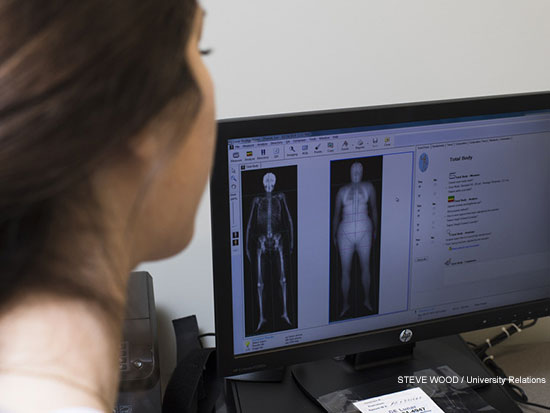 Managing the complicated strands of clinical research can be overwhelming, especially for younger investigators. Research Macro aims to be a "journey-management tool" that connects teams and research participants intelligently through a study's life cycle.This summer, UAB’s Harbert Institute for Innovation and Entrepreneurship awarded more than $300,000 to faculty and staff with ideas for new products and processes that needed proof-of-concept or early-stage product development support to reach their commercialization potential. Eleven projects received funding of $10,000 to $50,000, made possible by the Regional Innovation Strategies program from the U.S. Economic Development Administration.
Managing the complicated strands of clinical research can be overwhelming, especially for younger investigators. Research Macro aims to be a "journey-management tool" that connects teams and research participants intelligently through a study's life cycle.This summer, UAB’s Harbert Institute for Innovation and Entrepreneurship awarded more than $300,000 to faculty and staff with ideas for new products and processes that needed proof-of-concept or early-stage product development support to reach their commercialization potential. Eleven projects received funding of $10,000 to $50,000, made possible by the Regional Innovation Strategies program from the U.S. Economic Development Administration.
What are these projects, and who are the inventors behind them? The Reporter met with several grant recipients to learn more about their ideas and their advice to colleagues considering commercialization opportunities of their own.
This week’s project is Research Macro: A Research and Research Participant Journey, led by Mohanraj Thirumalai, Ph.D., assistant professor in the Department of Health Services Administration and director of Information and Communication Technology for the UAB/Lakeshore Foundation Research Collaborative.
Research Macro, Thirumalai said, aims to be a “journey-management tool” for researchers and research participants — a HIPAA-compliant, cloud-based software platform that integrates workflow, compliance, recruitment, retention, scheduling, documents and more. Research Macro connects teams and research participants intelligently throughout a study’s life cycle by leveraging some of the same automation and artificial intelligence techniques that Salesforce has used to revolutionize the digital marketing industry.
With his Regional Innovation Strategies grant funding, Thirumalai plans to perform customer discovery and further develop a minimum viable product for use in validation activities.
Where did your idea come from?
“From my own experience as a new researcher, getting started with my own grants,” Thirumalai said. “There are so many things to take care of when you are starting new projects: institutional review boards, compliance, recruitment, publishing. I wanted a software tool to help me manage all of my projects.”

“What if all of this was in a single tool — research planning and management, along with secure, tailored and timely communications? And what if it was automatic, capable of sending thank-you emails and reminders and other communications to participants? That is the idea of Research Macro.”
— Mohanraj Thirumalai, Ph.D., assistant professor in the Department of Health Services Administration and director of Information and Communication Technology for the UAB/Lakeshore Foundation Research CollaborativeWhat problem does it solve?
“Research projects quickly spin out a cobweb of tasks and documents to track, and that tracking typically happens with a mix of sticky notes, Outlook calendars, Google Drive folders, spreadsheets and multiple different proprietary software platforms. When that research involves humans, you have to maintain communication with them. If your participants aren’t happy, they won’t stick with your project.
“Meanwhile, faculty are scrambling between teaching, service and research. As the researcher’s number of grants increases, the structure becomes increasingly complex, with project coordinators and staff often filling different roles on each project. At the same time, the researcher and staff may be keeping track of 500 study participants across those projects.
“What if all of this was in a single tool — research planning and management, along with secure, tailored and timely communications? And what if it was automatic, capable of sending thank-you emails and reminders and other communications to participants? That is the idea of Research Macro.
“This will not be a static platform. We want to actively integrate evidence-driven best practices into the system. We also want to use artificial intelligence to predict research participant retention; to predict who will stay with your project. If you are asking someone to come and run on a treadmill in your lab three times a week, and you are dealing with Chicago’s cold winters, you need to be able to focus on participants who will stick with your study. If we can predict that after two or three visits a participant will not come back, based on patterns in their behavior during those visits such as arriving late, for example, that will be a valuable service for researchers.”
Is there anything on the market like this?
“Clinical trial management software is not new; UAB has a comprehensive system and there are several companies in this space. But they are focused on large, intensive operations, with a focus on insurance billing, regulatory affairs, etc. And they are expensive. They are not at a level where a school of health professions or public health or business can use them. Licenses can cost $5,000 or more per year for a single principal investigator. We want to bring down the cost significantly. We think we can be a successful second player in the arena by targeting early- or mid-career researchers. Our product will be applicable to both clinical trials and other forms of research involving human participants.”
What factors convinced you to move forward into commercialization?
“I have 20 years of experience building research-related technologies. I have created several digital health tools elsewhere and at UAB in my position as director of Information and Communication Technology for the UAB/Lakeshore Foundation Research Collaborative. I have been developing this Research Macro idea for about four years. I had a personal goal of getting my first grant and that happened about a year back. I just got my second one. This was the right time, and my dean is very supportive. Dean [Andrew] Butler has been instrumental in my deciding to go forward. He meets with me monthly to discuss entrepreneurial initiatives.”
Is this the first time you have worked with the HIIE?
“In my work with the UAB/Lakeshore Research Collaborative we have several commercialization efforts that we are trying to move to the next level in collaboration with the Harbert Institute.”
Do you have any advice for others in the UAB community who may have an innovative or entrepreneurial project in mind?
“First, I think this i6 project is a wonderful opportunity — it’s a non-intimidating, very friendly setup that the Harbert Institute has. I think anyone with an idea in mind should approach them. They are willing to help. And second, if you do have an idea, you have to take it forward. There will always be many naysayers. Ignore them and keep refining your idea.”
